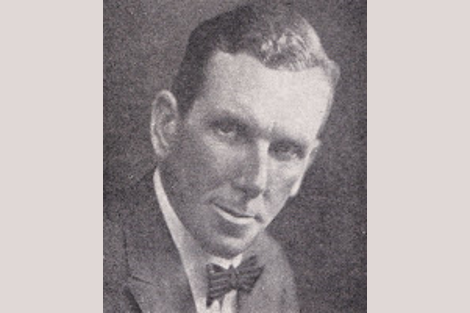

On any building in the course of erection you will see large notices ‘Builders so and so’, ‘Concrete work by someone else’, and so on; but you may look all over and you won’t find the author’s name.
George Wittet
More than 96 years ago, on 10 September 1926, Bombay lost its most notable architect at the young age of 48. George Wittet was born in 1878 in Scotland and came to Bombay in 1904 as an assistant to John Begg, then Consulting Architect to the Bombay Government.
George Wittet, original Bombay’s architect no. 1, was the designer of the city’s known public buildings and memorials. Most popular landmarks among them are the Gateway of India, Prince of Wales Museum of Western India (renamed as Chhatrapati Shivaji Maharaj Vastu Sangrahalaya), Royal Institute of Science, and Cawasji Jehangir Hall, which now houses the National Gallery of Modern Art, the new Customs House, the Court of Small Causes, the King Edward Memorial Hospital, the extension to the University Buildings, the Port Trust War Memorial in the city as well as the Agricultural College and the Central Government Offices at Poona elsewhere in the Bombay Presidency.
Wittet’s buildings are still standing and going strong as they age – that is, adding historic value with grace and splendour. Almost all his sites are marked in the city’s heritage list (1995) for their architectural merit and distinct composition. Be they the public sites or private buildings like the Central Bank of India and sites across it, the old building of Sir JJ College of Architecture, Readymoney Mansion, another business house on Waudby Road, or the Ballard Estate design controls, Wittet’s work has always been noticed and noted.
Introduced to India by Begg, Wittet was appointed his successor as Consulting Architect to the Bombay Government in 1908. In 1919 George Wittet gave up Government Service and joined the Tata Engineering Company, but returned to his old appointment in 1925. George Wittet was elected president of the Bombay Architectural Association (known as the Indian Institute of Architects today) for the years 1917 to 1920, and in 1924 he was elected president of the Bombay Engineering Congress. Despite his heavy professional duties, he found time to personally conduct architectural classes at the Bombay School of Art for many years.
John Begg wrote of Wittet’s untimely demise,
…an immense appetite for work and, not the least, an arresting personality that could sweep away difficulties, reconcile divergent interests and inspire the most lethargic with a spirit of enthusiastic cooperation. The tragedy of his death while still under 50 is one of the most nearly commemorable of the events of his remarkable career in India.
On the 15th of November 1928, Sir Leslie Wilson, then Governor of Bombay, unveiled the memorial tablet erected at the ‘Gateway of India’ in his memory.
George Wittet’s creations in the city are familiar reminders of the architect’s genius. He was also particular about due credit to be given to an architect. Wittet wrote (1922),
On any building in the course of erection you will see large notices ‘Builders so and so’, ‘Concrete work by someone else’, and so on; but you may look all over and you won’t find the author’s name. Until quite recently professional etiquette debarred him from putting it up, now the Royal Institute has sanctioned it being put up ‘in an inconspicuous manner’, such is our natural modesty. As a matter of fact, the position should be reversed, the architect’s name should be prominently displayed and the contractor’s in an inconspicuous manner, and later when the work is complete it should bear the author’s signature in such a manner as all may see and readily identify the architect with his work.
His work remains to remind us of the creative designer. George Wittet was buried in the Christian cemetery at Sewree, and a carved stone marked the identity of the grave. In 2001, the stone was given a white tint and the engraved lettering was painted in black to highlight the identity 75 years after he was laid to rest. This layer of sensitivity marked a new beginning in caring for not just the built heritage but also valuing it by acknowledging its creator. Highlighting the gravestone was a drop in the ocean. His architectural work needs many such gestures from all quarters and with due acknowledgement to the original creator – the one and only, George Wittet.
This article by Harshad Bhatia was first published titled George Wittet: Architect of many of the City’s landmarks, in The Times of India, Mumbai Mirror on 29 January 2023.
Featured Image credits: artdecomumbai.com







